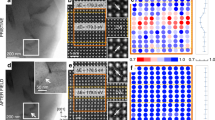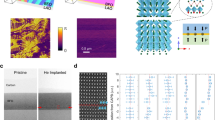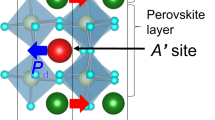Abstract
Mobile charged defects, accumulated in the domain-wall region to screen polarization charges, have been proposed as the origin of the electrical conductivity at domain walls in ferroelectric materials. Despite theoretical and experimental efforts, this scenario has not been directly confirmed, leaving a gap in the understanding of the intriguing electrical properties of domain walls. Here, we provide atomic-scale chemical and structural analyses showing the accumulation of charged defects at domain walls in BiFeO3. The defects were identified as Fe4+ cations and bismuth vacancies, revealing p-type hopping conduction at domain walls caused by the presence of electron holes associated with Fe4+. In agreement with the p-type behaviour, we further show that the local domain-wall conductivity can be tailored by controlling the atmosphere during high-temperature annealing. This work has possible implications for engineering local conductivity in ferroelectrics and for devices based on domain walls.
This is a preview of subscription content, access via your institution
Access options
Subscribe to this journal
Receive 12 print issues and online access
$259.00 per year
only $21.58 per issue
Buy this article
- Purchase on Springer Link
- Instant access to full article PDF
Prices may be subject to local taxes which are calculated during checkout



Similar content being viewed by others
References
Yang, S. Y. et al. Above-bandgap voltages from ferroelectric photovoltaic devices. Nat. Nanotech. 5, 143–147 (2010).
Kim, Y.-M. et al. Direct observation of ferroelectric field effect and vacancy-controlled screening at the BiFeO3/LaxSr1−xMnO3 interface. Nat. Mater. 13, 1019–1025 (2014).
Spurgeon, S. R. et al. Polarization screening-induced magnetic phase gradients at complex oxide interfaces. Nat. Commun. 6, 6735 (2015).
Catalan, G., Seidel, J., Ramesh, R. & Scott, J. F. Domain wall nanoelectronics. Rev. Mod. Phys. 84, 119–156 (2012).
Seidel, J. et al. Conduction at domain walls in oxide multiferroics. Nat. Mater. 8, 229–234 (2009).
Guyonnet, J., Gaponenko, I., Gariglio, S. & Paruch, P. Conduction at domain walls in insulating Pb(Zr0.2Ti0.8)O3 thin films. Adv. Mater. 23, 5377–5382 (2011).
Schröder, M. et al. Conducting domain walls in lithium niobate single crystals. Adv. Funct. Mater. 22, 3936–3944 (2012).
Du, Y. et al. Domain wall conductivity in oxygen deficient multiferroic YMnO3 single crystals. Appl. Phys. Lett. 99, 252107 (2011).
Meier, D. et al. Anisotropic conductance at improper ferroelectric domain walls. Nat. Mater. 11, 284–288 (2012).
Lubk, A., Gemming, S. & Spaldin, N. A. First-principles study of ferroelectric domain walls in multiferroic bismuth ferrite. Phys. Rev. B 80, 104110 (2009).
Morozovska, A. N., Vasudevan, R. K., Maksymovych, P., Kalinin, S. V. & Eliseev, E. A. Anisotropic conductivity of uncharged domain walls in BiFeO3 . Phys. Rev. B 86, 085315 (2012).
Morozovska, A. N. Domain wall conduction in ferroelectrics. Ferroelectrics 438, 3–19 (2012).
Xiao, Y., Shenoy, V. B. & Bhattacharya, K. Depletion layers and domain walls in semiconducting ferroelectric thin films. Phys. Rev. Lett. 95, 247603 (2005).
Hong, L. & Soh, A. K. Interaction of O vacancies and domain structures in single crystal BaTiO3: two-dimensional ferroelectric model. Phys. Rev. B 77, 094104 (2008).
Oh, Y. S., Luo, X., Huang, F.-T., Wang, Y. & Cheong, S.-W. Experimental demonstration of hybrid improper ferroelectricity and the presence of abundant charged walls in (Ca, Sr)3Ti2O7 crystals. Nat. Mater. 14, 407–413 (2015).
Seidel, J. et al. Domain wall conductivity in La-doped BiFeO3 . Phys. Rev. Lett. 105, 197603 (2010).
Farokhipoor, S. & Noheda, B. Local conductivity and the role of vacancies around twin walls of (001) − BiFeO3 thin films. J. Appl. Phys. 112, 052003 (2012).
Farokhipoor, S. & Noheda, B. Conduction through 71° domain walls in BiFeO3 thin films. Phys. Rev. Lett. 107, 127601 (2011).
Stolichnov, I. et al. Persistent conductive footprints of 109° domain walls in bismuth ferrite films. Appl. Phys. Lett. 104, 132902 (2014).
Stolichnov, I. et al. Bent ferroelectric domain walls as reconfigurable metallic-like channels. Nano Lett. 15, 8049–8055 (2015).
Shao, Y., Maunders, C., Rossouw, D., Kolodiazhnyi, T. & Botton, G. A. Quantification of the Ti oxidation state in BaTi1−xNbxO3 compounds. Ultramicroscopy 110, 1014–1019 (2010).
Choi, T. et al. Insulating interlocked ferroelectric and structural antiphase domain walls in multiferroic YMnO3 . Nat. Mater. 9, 253–258 (2010).
Chiu, Y.-P. et al. Atomic-scale evolution of local electronic structure across multiferroic domain walls. Adv. Mater. 23, 1530–1534 (2011).
Seidel, J. et al. Electronic properties of isosymmetric phase boundaries in highly strained Ca-doped BiFeO3 . Adv. Mater. 26, 4376–4380 (2014).
Crassous, A., Sluka, T., Taganstev, A. K. & Setter, N. Polarization charge as a reconfigurable quasi-dopant in ferroelectric thin films. Nat. Nanotech. 10, 614–648 (2015).
Whyte, J. R. & Gregg, J. M. A diode for ferroelectric domain-wall motion. Nat. Commun. 6, 7361 (2015).
Rojac, T., Ursic, H., Bencan, A., Malic, B. & Damjanovic, D. Mobile domain walls as a bridge between nanoscale conductivity and macroscopic electromechanical response. Adv. Funct. Mater. 25, 2099–2108 (2015).
Bednyakov, P. S., Sluka, T., Tagantsev, A. K., Damjanovic, D. & Setter, N. Formation of charged ferroelectric domain walls with controlled periodicity. Sci. Rep. 5, 15819 (2015).
He, L. & Vanderbilt, D. First-principles study of oxygen-vacancy pinning of domain walls in PbTiO3 . Phys. Rev. B 68, 134103 (2003).
Streiffer, S. K. et al. Domain patterns in epitaxial rhombohedral ferroelectric films. I. Geometry and experiments. J. Appl. Phys. 83, 2742–2753 (1998).
Nelson, C. T. et al. Spontaneous vortex nanodomain arrays at ferroelectric heterointerfaces. Nano Lett. 11, 828–834 (2011).
Phillips, P. J. et al. Atomic-resolution defect contrast in low angle annular dark-field STEM. Ultramicroscopy 116, 47–55 (2012).
Wang, Y. et al. Domain wall energies and structures: a combined experimental and density functional theory + U study. Phys. Rev. Lett. 110, 267601 (2013).
Aschauer, U., Pfenninger, R., Selbach, S. M., Grande, T. & Spaldin, A. Strain-controlled oxygen vacancy formation and ordering in CaMnO3 . Phys. Rev. B 88, 054111 (2013).
Makhdoom, A. R. et al. Association of microstructure and electric heterogeneity in BiFeO3 . Mater. Chem. Phys. 143, 256–262 (2013).
Morozov, M., Einarsrud, M.-A. & Grande, T. Atmosphere controlled conductivity and Maxwell-Wagner relaxation in Bi0.5K0.5TiO3–BiFeO3 ceramics. J. Appl. Phys. 115, 044104 (2014).
Wefring, E. T., Einarsrurd, M.-A. & Grande, T. Electrical conductivity and thermopower of (1 − x)BiFeO3–xBi0.5K0.5TiO3(x = 0.1, 0.2) ceramics near the ferroelectric to paraelectric phase transition. Phys. Chem. Chem. Phys. 17, 9420–9428 (2015).
Mizusaki, J., Sasamoto, T., Cannon, W. R. & Bowen, H. K. Electronic conductivity, Seebeck coefficient, and defect structure of LaFeO3 . J. Am. Ceram. Soc. 65, 363–368 (1982).
Hodges, J. P., Short, S. & Jorgesen, J. D. Evolution of oxygen-vacancy ordered crystal structures in the perovskite series SrnFenO3n−1 (n = 2, 4, 8, and ∞), and the relationship to electronic and magnetic properties. J. Solid State Chem. 151, 190–209 (2000).
Tan, H., Verbeeck, J., Abakumov, A. & Van Tendeloo, G. Oxidation state and chemical shift investigation in transition metal oxides by EELS. Ultramicroscopy 116, 24–33 (2012).
LeBeau, J. M. & Stemmer, S. Experimental quantification of annular dark-field images in scanning transmission electron microscopy. Ultramicroscopy 108, 1653–1658 (2008).
Zhang, Z., Wu, P., Chen, L. & Wang, J. Density functional theory plus U study of vacancy formations in bismuth ferrite. Appl. Phys. Lett. 96, 232906 (2010).
Paudel, T. R., Jaswal, S. S. & Tsymbal, E. Y. Intrinsic defects in multiferroic BiFeO3 and their effect on magnetism. Phys. Rev. B 85, 104409 (2012).
Matsuo, H., Kitanaka, Y., Inoue, R., Noguchi, Y. & Miyayama, M. Switchable diode-effect mechanism in ferroelectric BiFeO3 thin film capacitors. J. Appl. Phys. 118, 114101 (2015).
Maso, N. & West, A. R. Electrical properties of Ca-doped BiFeO3 ceramics: from p-type semiconduction to oxide-ion conduction. Chem. Mater. 24, 2127–2132 (2012).
Tsurumaki, A., Yamada, H. & Sawa, A. Impact of Bi deficiencies on ferroelectric resistive switching characteristics observed at p-type Schottky-like Pt/Bi1−δFeO3 interfaces. Adv. Funct. Mater. 22, 1040–1047 (2012).
Dyre, J. C. The random free-energy barrier model for ac conduction in disordered solids. J. Appl. Phys. 64, 2456–2468 (1988).
Douglas, A. M., Kumar, A., Whatmore, R. W. & Gregg, J. M. Local conductance: a means to extract polarization and depolarizing fields near domain walls in ferroelectrics. Appl. Phys. Lett. 107, 172905 (2015).
Lee, P. W. et al. Hidden lattice instabilities as origin of the conductive interface between insulating LaAlO3 and SrTiO3 . Nat. Commun. 7, 12773 (2016).
Khansur, N. H. et al. Electric-field-induced domain switching and domain texture relaxations in bulk bismuth ferrite. J. Am. Ceram. Soc. 98, 3884–3890 (2015).
Acknowledgements
This work was financed by the Slovenian Research Agency (programmes P2-0105 and P2-0393; projects J2-5483 and J2-6754). Centres of Excellence NAMASTE and CONOT are acknowledged for access to the AFM/PFM and STEM equipment. B. Kmet is acknowledged for TEM sample preparation. T.R. thanks T. Grande for fruitful discussions on the defect chemistry of BiFeO3.
Author information
Authors and Affiliations
Contributions
T.R. directed the project. A.B., G.D. and N.S. performed STEM and EELS measurements and analyses, and G.D. performed HAADF simulations. H.U. performed AFM/PFM analyses. B.J. and G.T. designed standard materials for EELS analysis. M.M. synthesized the BiFeO3 samples. B.M. supervised the project and D.D. contributed to the interpretation of the results. T.R., A.B., G.D., H.U., B.J., J.W. and D.D. wrote the manuscript. All authors reviewed and edited the manuscript.
Corresponding author
Ethics declarations
Competing interests
The authors declare no competing financial interests.
Supplementary information
Supplementary Information
Supplementary Information (PDF 1162 kb)
Rights and permissions
About this article
Cite this article
Rojac, T., Bencan, A., Drazic, G. et al. Domain-wall conduction in ferroelectric BiFeO3 controlled by accumulation of charged defects. Nature Mater 16, 322–327 (2017). https://doi.org/10.1038/nmat4799
Received:
Accepted:
Published:
Issue Date:
DOI: https://doi.org/10.1038/nmat4799
This article is cited by
-
Structural degeneracy and formation of crystallographic domains in epitaxial LaFeO3 films revealed by machine-learning assisted 4D-STEM
Scientific Reports (2024)
-
In-plane charged antiphase boundary and 180° domain wall in a ferroelectric film
Nature Communications (2023)
-
In-plane charged domain walls with memristive behaviour in a ferroelectric film
Nature (2023)
-
Direct investigation of the atomic structure and decreased magnetism of antiphase boundaries in garnet
Nature Communications (2022)
-
Anisotropic dislocation-domain wall interactions in ferroelectrics
Nature Communications (2022)



